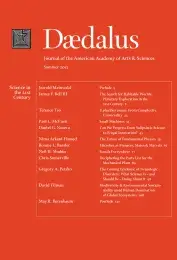Can We Progress from Solipsistic Science to Frugal Innovation?
Energy demand in the twenty-first century will be driven by the needs of three billion people in the emerging world and three billion new inhabitants to our planet. To provide them with a renewable and sustainable energy supply is perhaps the greatest challenge for science in the twenty-first century. The science practiced to meet the energy needs of the twentieth century responded to a society of wealth, and energy systems were designed to be large and centralized. However, the inability of the emerging world to incur large capital costs suggests that a new science must be undertaken, one that does not rely on economy of scale but rather sets as its target highly manufacturable and distributed energy systems that are affordable to the poor. Only in this way can science provide global society with its most direct solution for a sustainable and carbon-neutral energy future.
Solipsism is “the view or theory that self is the only object of real knowledge or the only thing really existent.”1 Deriving from the Latin sō-lus (“alone”) and ipse (“self”), solipsism–in its most extreme form–drives one to question whether an external world exists outside the mind. In many ways, the twentieth century was the century of solipsistic science. Science was practiced for the part of society that the scientist lived in and could observe. Because typical science is an expensive endeavor, that society was in large part one of affluence. Indeed, the knowledge and technology generated from the science of the twentieth century has served the developed world well. Any scientific or technological advance that immediately comes to mind inevitably originates from a handful of territories (for example, North America, Europe, Russia, Japan) with relatively high GDPs. But the benefits of this work have had little crossover to the poorer parts of the less-developed world.
Arguably, the inability of twentieth-century science to penetrate the underdeveloped world is rooted in cost. Research has been preoccupied with invariably expensive targets: the “best” or the “most efficient” for the materials scientist, the “fastest” for the enzymologist, the “biggest” for the high energy physicist, or the “smallest” for the nanoscientist, to name a few. For this reason, science and technology in the last century served the needs defined by the voice of affluence. But a new voice is audible in the twenty-first century. It is a whisper now but soon will be a cacophony of overwhelming numbers. Will science respond to the needs of the underdeveloped and emerging world in the coming century, and will it do so with sufficient alacrity to address the most urgent issues affecting global society?
. . .
